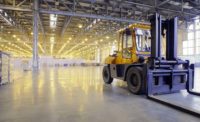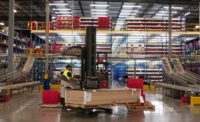3D printing, delivery bots and platoons of driverless trucks are transforming how goods are manufactured, shipped and distributed. What’s more is more and more of today’s industrial facilities are being built for both humans and robots, according to a report published by Cushman & Wakefield, Chicago.
Here are some key takeaways from the study, “Tech Disruptors and the Supply Chain:”
- Adoption of disruptive supply chain technologies could double in the next 5 years, affecting the speed, accuracy and cost of delivery of products. The resulting disruption to supply chain-related commercial real estate is expected to be widespread, and will redefine where facilities are located and designed. Additionally, these technologies will lead to a very different customer experience.
- Clearer differentiations in asset quality are likely to emerge. For instance, some technologies—such as advanced automation/robotics—require higher ceilings and very flat floors.
- Last-mile delivery and services will also be transformed. As technology facilitates same-day delivery, the need for urban warehousing for high-velocity goods will increase.
- Industrial real estate in particular, including the current last-mile delivery model, will be affected, as will retail space. Real estate development as a whole will also be impacted by 3D printing.
- Two-thirds of the total industrial inventory in the United States is devoted to logistics and a majority (60%) of the available space is more than 20 years old. Over half of the inventory has clear heights below 28 feet. This limits options for tenants seeking modern space, although construction is also at historic highs to meet some of this demand.
- Supply chain commercial real estate of the future will not just be built for people, but also for robots. The average rentable building area for newly delivered warehouse product has increased by 60% nationwide over the past 20 years, partly due to increased inventories driven by e-commerce. Clearer differentiations in asset quality are likely to emerge as some technologies—such as advanced automation/robotics—require higher ceilings (32-36 feet clear) and very flat floors.
- In order for existing inventory to keep pace and avoid becoming obsolete, certain design considerations will need to be implemented.
- However, closer to urban cores, warehouse/distribution facilities will be smaller and less automated than regional distribution centers, which will focus on labels, stocking and picking. Infill locations will more than likely need to maintain lower ceiling heights for high-velocity goods.
- The logistics map will also be redrawn to some extent. Demand for warehouses in major port markets such as Los Angeles and Inland Empire, those close to large population centers (e.g., New Jersey) and in major distribution hubs, including Chicago and Atlanta, will remain strong due to the ever-increasing need for services. Fully autonomous logistics—although still decades away— will, however, lower transportation costs and make remote locations such as secondary/tertiary markets, where commercial real estate costs are typically lower, become more attractive.



